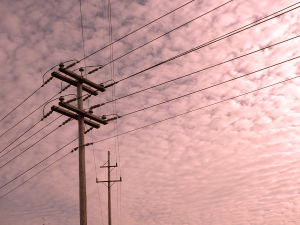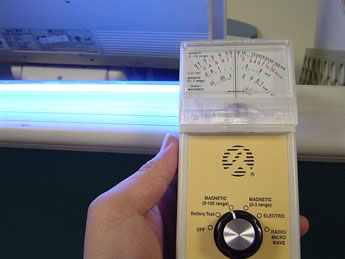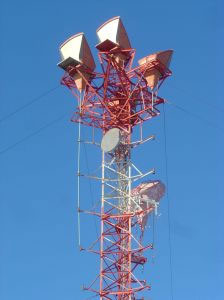EMF – Radiation In Our Home – Does Power Corrupt?
Another great article describing side effects of electromagnetic pollution. Many people are sensitive to this kind of radiation and can became seriously ill. You can find out more about a man, who became healthy, slept better after he protected himself against these harmful waves. Read this article because it can improve your sleep. Many sleepless night may be caused by EMF that are constantly disturbing the harmony in your body and cause ill health, in worst case cancer. There are some options that a person can protect himself against these waves and in the future I will publish videos where I have been measuring the EMF radiations of power lines, mobile phones, home appliances and other sources of EMF.
Kevin Byrne is a man in the prime of his life who feared he had an old man’s problems. Last summer, he was devastated by chronic back pain and thought his hips were about to give out.”I’m thinking, gee, I’m 47 years old and I’m going to need hip replacements already,” he said.
The hip pain was the beginning of a strange personal odyssey for Mr. Byrne, a technical writer who lives in Newcastle, a bedroom community east of Toronto. He is now convinced his ailment wasn’t a sign of premature aging, but an allergy to one of modern society’s ubiquitous substances: electricity.
No one knows how many people are sensitive to electricity. Scientific debate is intense over whether the condition exists or is a figment of people’s imagination. Some estimates place the number afflicted at a handful out of every million. Others view it as more common but still a tad unusual, perhaps a few individuals out of every thousand.
Mr. Byrne counts himself among those unlucky few. He began researching the topic when a neighbour expressed the belief that electricity was dangerous. In an act of desperation brought on by constant pain, he did something he initially thought was off-the-wall. He spent $1,000 on filters that, much like surge protectors on a computer, clean up fluctuations and surges in the electricity flowing in the wires around his home.
“When you’re in a lot of pain, you’ll do just about anything. So I was sort of grasping at non-medical straws,” he said. “I didn’t think they would work, to tell you the truth. I thought I was probably wasting my money.”
But within a couple of days, after months of pain for which his doctor could find no cause, he started feeling fine again. “I said to my wife, ‘This has got to be the placebo effect,’ ” he said, referring to the well-known medical phenomenon of patients reporting that they are cured of illnesses after being given a sugar pill doctors suggest will help them.
Mr. Byrne also noticed another odd health effect after he cleaned up his power, convincing him that electricity was at the root of his problems. Both he and his wife suddenly began to sleep more soundly and his dreams became “incredibly real and very vivid.”
Stories such as Mr. Byrne’s are not isolated tales. In fact, they’re becoming increasingly common, rising in lockstep with homes filled to the brim with electronic gadgets and the proliferation of wireless technologies.
Symptoms of electrical sensitivity include the joint pain Mr. Byrne experienced, but also a bewildering array of other common problems most everyone feels at one time or another, such as fatigue, headaches, poor sleep quality with frequent wakefulness, ringing in the ears, depression, difficulty remembering things, and skin rashes. The list of symptoms has created speculation that some cases of sick building syndrome, where people working in buildings complain of nausea and headaches, might be due to electrical sensitivities.
Madga Havas, an associate professor at the Environmental Studies Department of Trent University who is an expert on the health claims about electricity, says she receives “almost a call a day” from people who say electricity is making them ill and they can’t find help in the medical system. “It’s not just from Canada. It’s usually from the States as well,” she says.
She thinks the condition is more widespread than commonly thought, and speculates that for some people, exposure to electricity causes physiological stress, producing symptoms of tiredness, difficulty concentrating and poor sleep.
The possibility of such a widespread health impact from electricity is greeted with skepticism in the electricity industry, where such an effect would have wide-ranging consequences.
“We don’t have support to suggest that there is electro sensitivity in members of the population,” says Jack Sahl, a manager of safety and environmental issues at Southern California Edison, a large U.S. electricity provider.
The industry position has been bolstered by studies showing that most of those who say they have allergies to electricity are unable consistently to detect the presence of electric currents in laboratory experiments.
Medical authorities and scientific researchers have consequently been baffled over these wide-ranging claims of ill health, not only in Canada and the United States but in Britain and other European countries. In Sweden, the electrically sensitive are so numerous they have established their own self-help and lobby group.
Those with the condition bristle at suggestions their symptoms are imaginary. “This is not psychosomatic at all. . . . We’re not delusional,” says Susan Stankavich, who lives near Albany, N.Y., and says her problems developed after a large cell phone tower was erected near her home. She’s had debilitating headaches, among other symptoms, and can barely tolerate being under fluorescent lights.
Reacting to this rising tide of claims of a new illness, the World Health Organization issued a fact sheet in December on the allergies, which it dubbed “electromagnetic hypersensitivity” and likened it to multiple chemical sensitivities.
The WHO says the “symptoms are certainly real” and “can be a disabling problem for the affected individual.”
Reports about sensitivity to electricity began with the introduction of computers, predating the recent spread of Wi-Fi and cell phone towers, which release a related but more powerful type of electromagnetic energy than that produced around electric wires.
There have been long-running concerns about the possible health effects of electricity because it is a source of both electric and magnetic fields, invisible lines of force that surround all power lines and any power-consuming device, from the lowly kitchen toaster to a computer. Electric fields are always present near power wires and appliances, even when devices are turned off, but magnetic fields are generated only when devices are on.
The nerves in living things work on electrical impulses. So do other biological processes, such as the voltages in hearts detected using electrocardiographs. This has given rise to worries that man-made electricity fields, to which humans were never exposed before the modern era, might be biologically active, just like chemical pollutants.
The WHO has been looking at electrical sensitivity as one aspect of a larger investigation into the health effects of the *censored*tail of electromagnetic fields enveloping people in modern societies via everything from power lines to cell phones. It says that exposure to electromagnetic fields represents “one of the most common and fastest growing environmental influences, about which there is anxiety and speculation spreading.”
Until now, most of the medical researchers looking at electricity and health have searched for links to cancer, rather than the fatigue-related symptoms the electrically sensitive claim.
The cancer research has linked childhood leukemia to power-line magnetic fields. About 5 per cent of the U.S. population is regularly exposed to fields of the strength associated with leukemia in children, a percentage that is probably similar in Canada. For adult leukemia and brain tumours, some studies have found links to electricity, as they have with Lou Gehrig’s disease, but the research is less conclusive than that for childhood leukemia.
Richard Stevens, an epidemiologist at the University of Connecticut Health Center, has been studying electricity for nearly two decades, and first advanced the hypothesis that the use of electricity is a factor behind the rise in some cancer rates in developed countries. He says there is strong evidence linking the use of night lighting to cancer because exposure to light at night disrupts people’s production of the hormone melatonin.
But he’s unsure what impact the fields around electric wiring and devices might be having. Some studies have found that magnetic fields suppress melatonin in animals, something that might explain the allergy-like symptoms, but this effect hasn’t been observed in humans. “Whether or not magnetic fields have any effect at all, I do not know,” Dr. Stevens says.
The allergy-like symptoms are a far different medical condition than the cancers Dr. Stevens studies, and some researchers are speculating that a possible culprit is the recent deterioration in the quality of electricity flowing in power wires.
Power quality is a well-known problem in the utility business, caused by the proliferation of computers, lighting dimmer switches, energy efficient bulbs, and other modern electronic gadgets. These new devices cause a more complicated use pattern for electricity than old-fashioned items such as incandescent bulbs, producing negative feedback involving high-frequency peaks, harmonics and other noise on electric wiring.
The way to picture the quality effect is to imagine that electricity is like water flowing in a pipe. An incandescent bulb uses electricity steadily, just like an open tap allows a constant flow into the sink. Computers and other modern devices use power in variable amounts, similar to turning the tap on and off, or any setting in between, causing water pipes to clang.
This deterioration in power quality has been going on for years and would have likely escaped public notice, except that when home computers became popular in the 1990s they would frequently crash or malfunction because of it.
The change in power quality means more variable electromagnetic fields, and possibly more biologically active ones, are associated with electricity than there used to be. This is a possible explanation for the rise in electro sensitivity complaints in the view of Denis Henshaw, a professor at the University of Bristol in Britain, who is an international authority on the health effects of power transmission lines.
He says that if electricity were flowing in a constant way, most people’s bodies would likely adapt, but with all the interference from modern devices, the resulting fields are too variable for people to get used to. “We just don’t get to adapt to these because they don’t have any special pattern to them,” he said. “There is no proof of this, it’s just an opinion.”
In Canada, Dr. Havas has been investigating whether the deterioration in power quality has led to sensitivity. To this end, she’s been installing filters that clean up the interference on electrical wires to see if people notice.
In 2003, she installed filters in a Toronto private school where a student was electrically sensitive for a six-week test, three weeks with the devices and three weeks without them. Half of the teachers who responded to her questionnaire said they felt health improvements, such as being able to concentrate better and feeling less tired, when the filters were in place. Even more unusual, the teachers, who were not told what the research was about, reported that 60 per cent of their classes showed improvements in student behaviour when the filters were installed.


Based on this finding, Dr. Havas estimates that perhaps half of the population may have some sensitivity to electricity. In another test, she installed filters in the homes of people with multiple sclerosis, a disease that might be reactive to electricity because it is associated with poor sheathing on nerves. Brad Blumbergs, 29, says his MS improved so much last year that he could walk without shaking and could even run again. “It allows me to retire my cane,” he said. “It hasn’t cured me, but my symptoms are a percentage of what they used to be,” Mr. Blumbergs said.
Dr. Havas has presented some of these findings at scientific conferences on electro sensitivity, but the work hasn’t appeared in the gold standard of research, the peer-reviewed scientific journals that would confer more legitimacy on the results.
The utility industry’s Mr. Sahl is skeptical about efforts to improve power quality, which generally cost about $1,000 to handle one home, and calls them a “waste of money.”
He agrees that the action may make some people feel better, but only because they’re affected by the power of suggestion and not by the power of electricity. “I hate to be blunt about it, but there is this well-established effect in science and we’ve studied it over and over and it’s called the placebo effect.”
That doesn’t ring true to Mr. Byrne. He says his sensitivity might have been prompted by his decision last year to conserve energy by replacing much of his home’s simple incandescent lighting with high-efficiency compact fluorescent bulbs, some brands of which cause the power-quality problem.
He’s become so convinced that electricity can make people sick that he’s set up a website, offering tips to fellow sufferers on how to alleviate their symptoms, such as urging them to throw out their dimmer switches and limiting exposures to electronic gadgets. When it comes to electricity, Mr. Byrne says, “I think people should automatically begin changing their lifestyles.”
Source: Theglobeandmail




